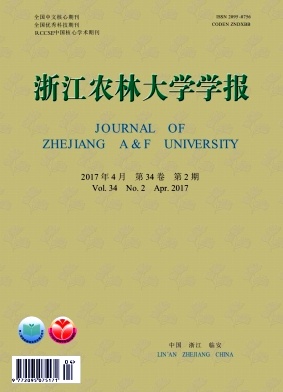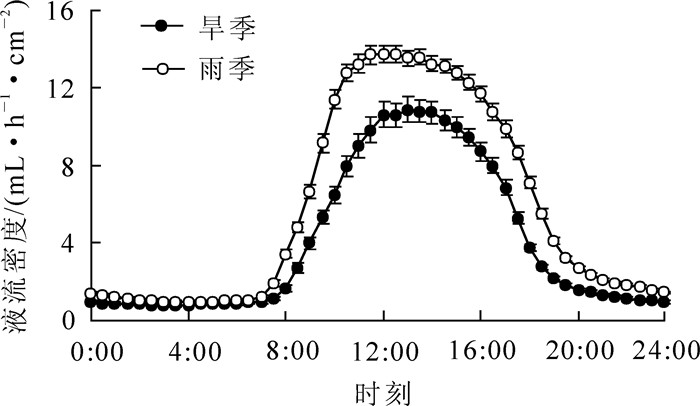-
水分是植物生长的重要影响因子之一。蒸腾作用作为植物吸水的主要动力,耗水占植物根部吸收水分的99%以上,因此,定量研究植物的蒸腾耗水一直是树木生理生态学和生态水文研究的重要方向[1-3]。热扩散探针法(thermal dissipation probe, TDP)利用热电转换原理,对自然生长状态下的植物进行连续树干液流测定,继而推算出单株和林分的蒸腾耗水[4],已得到国内外很多学者的认可[5-8]。桉树作为四大速生树种之一,具有速生丰产、耐贫瘠、干形通直等特点,是中国南方最主要的造林树种之一[9]。对桉树耗水的研究一直存在很多争议[10-11],一种观点认为大面积栽植桉树会造成水土流失,地下水位下降[12];另一观点肯定了桉树对水分和养分的利用率,并论证了建立桉树生态林的可能性和可行性[13],因此,研究桉树的蒸腾耗水具有重大的科学意义。很多学者都对此展开研究,张宁南[14]研究了尾叶桉Eucalyptus urophylla液流密度及其耗水特征,VERTESSY等[15]与WULLSCHEGER等[16]研究了王桉Eucalyptus regnans的树干液流动态,孙振伟等[17]对柠檬桉Corymbia citriodora水分利用特征的季节动态进行了研究。其他树种如柳杉Cryptomeria fortunei[18],杉木Cunninghamia lanceolata[19],杨树Populus[20]和马占相思Acacia mangium[6]等的树干液流特征及影响因子的研究也较多。尾巨桉Eucalyptus urophylla × E. grandis是桉树属最具有代表性的树种之一,广泛栽植于广东、广西等地,目前对尾巨桉蒸腾耗水的研究停留在阶段性观测上,对树干液流特征的长期连续观测很少,更未有针对中国南方地区旱雨两季尾巨桉的液流差异性的分析研究,仅有王文等[21]研究尾巨桉2个月树干液流特性及影响因子。由于桉树的栽植区域大多存在典型的旱季雨季之分,因此,本研究在之前工作的基础上采用Granier热扩散探针法对2年生尾巨桉树干液流连续观测,结合自动气象观测站对环境因子作同步测定,以期揭示尾巨桉旱雨两季蒸腾耗水特征的差异,为正确认识桉树的耗水问题提供数据支持,为桉树栽培及抚育提供指导。
HTML
-
研究区位于广东省湛江市桉树森林生态系统国家定位观测站(21°30′N,111°38′E),平地,海拔为80 m,属热带海洋性气候,年降水量为1 200.0~1 700.0 mm。全年降雨多集中在5-10月,占全年降水量的77%~85%,具有典型旱雨两季;年平均气温为23.0 ℃左右,最低气温0 ℃以上;太阳年辐射总量4 240 MJ·m-2左右,多年平均相对湿度在80%以上。试验区土壤类型主要是玄武岩砖红壤,土层厚度2.0 m以上,0~80 cm土层内平均有机质含量16.0 g·kg-1以上,pH 4.5~5.3,土壤肥力属中等水平。乔木层主要是尾巨桉E.urophylla × E. grandis,少量台湾相思Acacia confusa;灌木层有鹅掌柴Schefflera octophylla,白背叶Mallotus apelta,马缨丹Lantana camara等,草本层较为丰富。试验地造林树种为尾巨桉无性系32-29,造林密度1 666株·hm-2,造林时间为2012年7月,造林面积为2.0 hm2,造林方式为挖穴造林;其中2年生林分的平均胸径为8.48 cm,平均树高为9.78 m,平均冠幅为3.14 m × 3.60 m(东西×南北),叶面积指数平均为4.16。
-
选取20 m × 20 m的试验样地,选择生长状况良好、树干通直无挤压、无病虫害的标准木3株实施树干液流连续监测,监测时间2014年8月-2015年8月。样木各项参数见表 1。
样木编号 胸径/cm 树高/m 皮厚/cm 边材面积/cm2 树干位点高度/m 测定方位 1 9.6 10.8 0.3 32.9 1.3 北 2 8.3 9.8 0.2 26.2 1.3 北 3 8.7 10.1 0.2 28.1 1.3 北 Table 1. Basic conditions of the sample trees
树干液流的测定采用Granier热扩散法。由于样树胸径较小,茎流传感器采用2针型探针传感器(型号SF-G,探针长度33 mm,Ecomatik公司,德国),在1.3 m处安装,为避免不同方向上的液流差异同时防止日晒的影响,探针均安装在树干阴面,且用防辐射铝箔覆盖。采用美国Campbell公司的CR3000数据采集器采集数据,采集间隔为30 min。环境因子通过林外自动气象观测场同步测定,且所有气象数据均换算成30 min内的平均值,与液流数据一一对应。
-
液流密度取3株样木平均值分析作图,其中液流密度根据通用的GRANIER[22]液流公式进行计算。Js=0.011 9K1.231×3 600;K=(ΔTmax-ΔT)/ΔT。其中:Js为液流密度,是指单位边材面积单位时间内的液流量(mL·h-1·cm-2);ΔTmax为无液流时加热探针与参考探针的最大温差值,ΔT为测定温差值。
-
边材面积无法在树木生长的情况下直接测量,只能通过生长锥测定胸径处的边材厚度,然后量取胸径和树皮厚度,来计算边材面积。为避免生长锥对样树的影响,在试验地随机选取30株树木测定,建立起边材面积与胸径的关系方程,来推算样树和整个林分的边材面积。得到方程:As=0.438D2-2.701D+18.48。其中:As为边材面积(cm2),D为胸径(cm),然后通过样树胸径计算样树边材面积(表 1)。
-
树木的液流通量指单位时间树木的蒸腾耗水量,计算公式为:Fi=Js×As×10-3。Fi为液流通量(kg·h-1),根据相应时间尺度分为日通量(kg·d-1)和月通量(kg·月-1)。
-
应用Excel和SPSS统计软件对所有数据进行分析并作图。
1.1. 研究区概况
1.2. 研究方法
1.3. 数据处理
1.3.1. 液流密度
1.3.2. 边材面积
1.3.3. 树木的液流通量(单株尺度)
1.4. 统计分析
-
对旱雨两季液流密度所有日平均值分析并作图(图 1)。可以看出:尾巨桉树干液流密度呈现“昼高夜低”的变化规律,白天变化幅度较大,出现典型的宽峰形曲线。液流启动时间雨季为7:15左右,比旱季启动时间早0.5 h;从到达峰值时间来看,雨季为11:30,比旱季到达峰值早1.5 h;从峰值来看,雨季为13.69 mL·h-1·cm-2,是旱季的1.30倍;从日平均液流密度看,雨季全年平均值5.75 mL·h-1·cm-2,是旱季的1.43倍;液流迅速下降时间雨季为17:30,比旱季晚1.0 h左右,即雨季峰形要宽于旱季。

Figure 1. Features and differences of sap flow in daytime during both rainy and dry seasons of E. urophylla × E. grandis
分析夜间液流发现,旱雨两季夜晚尾巨桉均存在较大的液流现象,且前半夜的液流密度比后半夜要大,变化幅度也较大,后半夜液流密度较小且平稳。推测原因可能是后半夜树干水分接近饱和,夜晚水分补充的时间主要为前半夜。夜间液流现象主要由根压引起的,白天蒸腾所引起的水分缺失,会导致根压增大,为保持体内水分平衡[23-24],水分会以主动方式吸收进入植物。图 1还显示夜间树干液流密度雨季要大于旱季,变化幅度也明显大于旱季,推测原因可能是白天蒸腾作用雨季大于旱季,造成根压也是雨季大于旱季,从而导致夜间液流密度雨季大于旱季。
-
对尾巨桉旱雨两季日通量的分析可以看出(表 2),雨季最大日通量5.93 kg·d-1,为旱季的1.30倍;雨季最小日通量为0.66 kg·d-1,是旱季的6.00倍。对旱雨两季平均日通量计算得知,雨季平均日通量为3.99 kg·d-1,是旱季的1.50倍;平均月通量差异较大,雨季达到122.4 kg·月-1,为旱季的1.53倍。
季节 最大日通量/(kg.d-1) 最小日通量/(kg.d-1) 平均日通量/(kg.d-1) 平均月通量/(kg.月-1) 雨季 5.93 0.66 3.99±0.17 122.40±3.79 旱季 4.65 0.11 2.64±0.26 80.00±7.45 Table 2. Daily and month sap flow volume of E. urophylla xE. grandis in both rainy and dry seasons
-
树干液流密度变化除了受到树木生物学结构影响外,还受到周围气象因子的制约[25-26]。对雨季和旱季各月份树干液流密度与各气象因子指标作Pearson相关分析,结果如表 3。雨季树干液流密度与大气温度、风速、光合有效辐射以及水汽压亏缺呈极显著正相关(P<0.01),相关系数分别为0.79,0.39,0.91,0.79;与降雨量呈显著负相关(P<0.05),相关系数为0.08,而与空气湿度呈极显著负相关(P<0.01),相关系数为0.66,影响因子相关系数大小排序为光合有效辐射>水汽压亏缺、大气温度>空气湿度>风速>降水;旱季树干液流密度与大气温度、光合有效辐射和水汽压亏缺呈极显著正相关(P<0.01),相关系数分别为0.43,0.91,0.81,与空气湿度呈极显著负相关(P<0.01),相关系数为0.61,各影响因子的相关系数大小排序为光合有效辐射>水汽压亏缺>空气湿度>大气温度,而与风速和降水无显著相关性,造成差异的原因推测是旱季由于土壤水分供给能力的降低,干扰了部分环境因子对树干液流的影响。
季节 大气温度 空气湿度 风速 光合有效辐射 降水 水汽压亏缺 雨季 0.79ii -0.66** 0.39** 0.91** -0.08* 0.79** 旱季 0.43ii -0.61** -0.06 0.91** -0.03 0.81** 说明:** 为0.01水平上极显著相关,*为0.05水平上显著相关。 Table 3. The analysis of correlation between sap flow density in rainy and dry seasons and meteorological factors of E. urophylla x E. grandis
由此可知:影响尾巨桉旱雨两季树干液流密度的主要气象因子基本相同,分别是水汽压亏缺、光合有效辐射、空气湿度和大气温度,其中空气湿度极显著负相关,其余为极显著正相关;旱雨两季树干液流与气象因子间的相关性也有些许差异,雨季树干液流密度与风速极显著正相关,与降水量显著负相关,但旱季液流密度与两者之间的相关性不显著。
2.1. 尾巨桉旱雨两季树干液流变化分析
2.2. 尾巨桉旱雨两季日通量与月通量差异分析
2.3. 尾巨桉旱雨两季树干液流影响因子分析
-
对2~3年生尾巨桉旱雨两季树干液流的研究表明:旱雨两季树干液流均呈昼高夜低的变化趋势,其中日变化呈明显的单峰曲线,这与王文等[21]和任世奇等[27]对尾巨桉的研究结果一致。旱雨两季树干液流特征差异明显,主要表现在雨季白天启动时间和到达峰值的时间均早于旱季,液流峰值和维持液流高峰的时间雨季明显大于旱季。王小菲等[28]对大叶相思Acacia auriculaeformis干湿季树干液流研究认为,湿季光照强,气温高,相对湿度高,代谢旺盛且有充分的水分供给,是湿季液流速率平均值和峰值均大于干季的原因;其液流启动时间、到达峰值时间、液流变慢至低谷的时间表现出的差异性与本研究结果均一致,分析原因可能是雨季太阳辐射增强时间较早,下降时间晚,且日平均气温及日平均辐射强度较大,使得雨季白天蒸腾速率大于旱季。
尾巨桉夜间也存在较大的液流现象,依据GOLDSTEIN等[29]的理论,此时的液流活动是树体在存储水分,以弥补日间蒸腾引起的水分亏缺,研究发现旱雨两季夜间液流密度及变化幅度前半夜均大于后半夜,说明前半夜是水分补充的主要时期,这与王艳兵等[30]对华北落叶松夜间液流特征的研究结果一致;雨季夜晚液流密度、变化幅度均大于旱季,这与王华等[31]对马占相思Acacia mangium夜间液流变化幅度干季大于湿季的研究结果不同,原因可能是土壤供水情况和树木本身的生物学结构不同。
旱雨两季液流最大日通量、最小日通量、平均日通量雨季均大于旱季,且雨季平均月通量(122.4 kg·月-1)达到旱季的1.53倍,推测原因是雨季雨热同期,树木蒸腾速率较大;这与肖以华等[32]对马占相思树旱雨两季液流特征的研究结果一致。以上结果也可以确定雨季尾巨桉生长活跃,耗水量大,是水肥管理的重要时期。
旱雨两季影响尾巨桉树干液流密度的影响因子不完全相同,但主要气象因子相同。王瑞辉等[33]通过对元宝枫Acer truncatum生长旺季树干液流影响因素的分析发现,边材液流在不同的观测时段影响因子不完全相同,但在任何情况下气温都是影响液流的主导因子;黄德卫等[34]对鼎湖山针阔叶树种的研究中则有不同观点,他发现湿季影响各树种液流速率的主导环境因子为光合有效辐射,而干季影响各树种液流速率的主导环境因子则是气温。由此可见,随着时空位移的变化,影响树干液流的环境因子也会随季节变化而变化。







 DownLoad:
DownLoad: